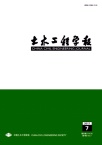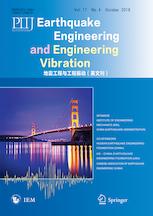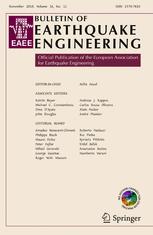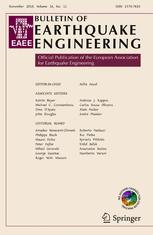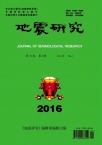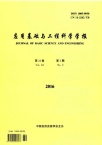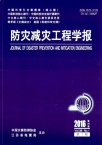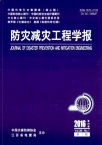学术论文列表
Vertical-to-horizontal response spectral ratio for offshore ground motions: Analysis and simplified design equation
摘要:In order to study the differences in vertical component between onshore and offshore motions, the vertical-to-horizontal peak ground acceleration ratio (V/H PGA ratio) and vertical-to-horizontal response spectral ratio (V/H) were investigated using the ground motion recordings from the K-NET network and the seafloor earthquake measuring system (SEMS). The results indicate that the vertical component of offshore motions is lower than that of onshore motions. The V/H PGA ratio of acceleration time histories at offshore stations is about 50% of the ratio at onshore stations. The V/H for offshore ground motions is lower than that for onshore motions, especially for periods less than 0.8 s. Furthermore, based on the results in statistical analysis for offshore recordings in the K-NET, the simplified V/H design equations for offshore motions in minor and moderate earthquakes are proposed for seismic analysis of offshore structures.
设置BRB桥梁排架墩基于位移抗震设计方法
摘要:基于"保险丝"和"损伤控制"的抗震设计理念,提出在桥梁双柱式排架墩中通过设置屈曲约束支撑(BRB)以提高其横桥向抗震性能的构想。首先从获得"抗震能力"的角度对设置BRB桥梁排架墩的抗震设计参数进行系统性分析,推导出与剪跨比和墩柱间距与直径(边长)比相关的BRB核心段最大和最小长度取值范围;再从求解"地震需求"角度建立了设置保险丝的(SDOF)主结构体系弹塑性反应谱基本方程,分析该体系的非线性地震反应一般规律;然后,基于体系的"抗震能力"和"地震需求",发展了设置BRB的桥梁排架墩基于位移的抗震设计方法,并结合一个具体桥梁排架墩实例说明建议设计方法的可行性。
Rapid repair techniques for severely earthquake-damaged circular bridge piers with flexural failure mode
摘要:In this study, three rapid repair techniques are proposed to retrofit circular bridge piers that are severely damaged by the flexural failure mode in major earthquakes. The quasi-static tests on three 1:2.5 scaled circular pier specimens are conducted to evaluate the efficiency of the proposed repair techniques. For the purpose of rapid repair, the repair procedure for all the specimens is conducted within four days, and the behavior of the repaired specimens is evaluated and compared with the original ones. A finite element model is developed to predict the cyclic behavior of the repaired specimens and the numerical results are compared with the test data. It is found that all the repaired specimens exhibit similar or larger lateral strength and deformation capacity than the original ones. The initial lateral stiffness of all the repaired specimens is lower than that of the original ones, while they show a higher lateral stiffness at the later stage of the test. No noticeable difference is observed for the energy dissipation capacity between the original and repaired pier specimens. It is suggested that the repair technique using the early-strength concrete jacket confined by carbon fiber reinforced polymer (CFRP) sheets can be an optimal method for the rapid repair of severely earthquake-damaged circular bridge piers with flexural failure mode.
Experimental and numerical investigations on the seismic behavior of bridge piers with vertical unbonded prestressing strands
摘要:In the performance-based seismic bridge design, piers are expected to undergo large inelastic deformations during severe earthquakes, which in turn can result in large residual drift and concrete crack in the bridge piers. In this paper, longitudinal unbonded prestressing strands are used to minimize residual drift and residual concrete crack width in reinforced concrete (RC) bridge piers. Seven pier specimens were designed and tested quasi-statically and the numerical simulations were carried out. The effectiveness of using vertical unbonded prestressing strands to mitigate the residual drift and concrete crack width of RC bridge piers are examined and discussed in detail. It is found that the residual drift and residual concrete crack width of the piers can be reduced significantly by using the prestressing strands. Moreover, the strands can increase the lateral strength of the piers while have little influence on the ductility capacity of the piers. The hysteretic curves, residual drifts and strand stress of the piers predicted by the numerical model agree well with the testing data and can be used to assess the cyclic behavior of the piers.
Research on the influencing factors for residual displacements of RC bridge columns subjected to earthquake loading
摘要:Following the 1995 Kobe earthquake, many RC bridge columns were demolished due to a residual drift ratio of more than 1.75 % even though they did not collapse. The residual drift ratio is a quantitative index for the performance objective of reparability in the bridge seismic design. Numerical models of the columns are built to study the factors that influence the residual displacement of RC bridge columns. In these models, both column bending and bar pulling out deformation are considered using the fiber column-beam element and zero-length section element, respectively. Then, nonlinear time history analyses are performed. The factors that influence column residual displacement, such as the characteristics of ground motion, the structural responses (the maximum lateral drift ratio and the displacement ductility factor), and the structural characteristics (the aspect ratio and the longitudinal reinforcement ratio) are investigated. It is found that the near-fault ground motion induces a larger residual drift ratio than the far-fault ground motion. The residual drift ratio becomes larger due to the increase of the maximum lateral drift ratio, the displacement ductility factor, and the aspect ratio. Further, a larger longitudinal reinforcement ratio can induce a larger residual drift ratio due to the contribution of the bar pulling out deformation.
粘弹性人工边界在地震工程中应用研究综述
摘要:介绍粘弹性人工边界在结构-地基动力相互作用等问题中应用的研究现状。重点叙述了粘弹性人工边界在有限元计算中的实现方法及其在地震工程中的应用。粘弹性人工边界方法具有方便实现、计算精度高、稳定性强等优点,是解决近场波动问题的一种重要手段。随着粘弹性人工边界理论及其在有限元软件中的应用日渐成熟,其在工程抗震分析等方面将具有广阔的应用前景。
考虑桥墩剪切破坏的不规则桥梁排架抗震分析模型
摘要:基于OpenSees数值分析平台的纤维梁柱、剪切弹簧和转动弹簧单元,建立了考虑桥墩剪切破坏的不规则桥梁排架抗震数值分析模型.其中纤维梁柱单元模拟桥墩、盖梁弯曲变形,剪切弹簧单元模拟桥墩剪切变形,转动弹簧单元模拟纵筋拔出变形.基于圆形截面桥墩抗震试验结果,并结合数值分析手段建立了桥墩剪切破坏时塑性铰区转角计算公式.并以此公式为基础,监测数值模型中桥墩剪切破坏,剪切破坏前桥墩以弯曲反应为主,剪切破坏后桥墩侧向强度和刚度发生显著退化.最后以3座实际不规则桥梁排架为工程背景,进行了排架横桥向地震作用下的滞回性能分析.研究表明,所建立的抗震分析模型可有效模拟由于桥墩剪切破坏造成的强度和刚度退化,为不规则桥梁结构抗震性能分析提供了依据.
弯曲破坏型钢筋混凝土桥墩地震变形成分及影响因素
摘要:钢筋混凝土桥墩拟静力试验表明,弯曲破坏型桥墩墩顶位移主要由弯曲变形、滑移变形成分构成。为进一步探讨地震荷载作用下弯曲破坏型桥墩地震变形成分及其影响因素,首先基于Lehman以及李贵乾的桥墩试件拟静力试验,利用OpenSees平台采用纤维梁柱单元模型附加零长度截面单元对试验滞回曲线和墩顶变形成分进行数值模拟;其次建立原型桥墩数值模型,考虑近断层和远断层地震动进行了非线性动力时程分析,探讨了最大侧移角、位移延性系数等结构反应参数,以及剪跨比、纵筋配筋率等构件特征参数对桥墩地震变形成分的影响。结果表明,墩顶总位移中纵筋粘结滑移成分随最大侧移角和位移延性的增大而增大,随剪跨比和纵筋配筋率的增大而减小。考虑纵筋粘结滑移的数值模型与仅考虑弯曲变形纤维梁柱单元模型相比,将增大桥墩的地震位移反应。
海底地震动特性及相关谱研究
摘要:利用日本K-NET与美国SEMS台网中海底强震记录研究了海底地震动特性。通过分析水平反应谱、竖向与水平加速度反应谱的比谱和弹塑性反应谱,比较了海底与陆地地震动的区别。发现海底竖向地震动的峰值加速度明显更低。在大于0.2s的周期段,海底水平地震动反应谱大于陆地谱值,而且海底谱具有更长的特征周期,并随震中距增长而增大。此外,海底地震动的竖向与水平加速度反应比谱与陆地地震动的差异很大,在小于1s的中短周期段海底地震动的比谱明显更小。根据不同的震级与震中距的真实地震动记录,提出了中等地震下不同震中距海底地震动比谱的简化设计方程。最后,比较了海底与陆地地震动的弹塑性反应谱,可知总体上海底与陆地的等延性强度折减系数谱差异不大。
基于位移的中等跨径减隔震桥梁抗震设计方法
摘要:为了给新建减隔震桥梁设计和既有桥梁减隔震加固设计提供参考,以中等跨径的公路桥梁为研究对象,结合中国的抗震设计规范和减隔震支座技术标准,提出一种基于位移的抗震设计方法。该设计方法给出了选择减隔震支座和估计设计目标位移的方法,从串联体系受力特点的角度提出了桥墩-支座体系的位移分配方法,设计中允许桥墩屈服,但通过控制损伤程度确保震后不需要修复,也要求进行支座的安全性检验。构造了具有不同外形特征和不同跨径的36座连续梁桥进行减隔震设计,并通过动力时程分析验证了设计方法的可行性。研究结果表明:提出的设计方法能够较好地预测主梁的位移需求,易于把握支座和桥墩的性能状态;该设计方法也适用于非规则桥梁,可通过横向位移变异系数判断主梁的横向位移变形模式。
©2026 王东升-桥梁抗震与减震控制研究团队 京ICP备18023726号-1
技术支持: Geecho

